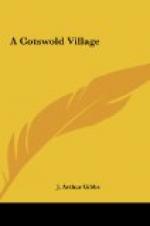[Illustration: The Old Mill, Ablington. 152.png]
CHAPTER VII.
A COTSWOLD TROUT STREAM.
“We may say of angling as Dr. Boteler said of strawberries: Doubtless God could have made a better berry, but doubtless God never did; and so, if I might be judge, God never did make a more calm, quiet, innocent recreation than angling.’”—The Compleat Angler.
Very few trout we have caught this season (’98) are pink-fleshed when cooked. Last year there were a good number. The reason probably is that they have not been feeding on the fresh-water shrimps or crustaceans, owing to the abundance of olive duns and other flies that have been on the water. Last winter, being so mild, was very favourable for the hatching out of fly in the spring. A hard winter doubtless commits sad havoc among the caddis and larvae at the bottom of the river; the trout, not being able to get much fly, are then compelled to fall back on the crustaceans. The food in these limestone rivers is so plentiful that the fish are able to pick and choose from a very varied bill of fare. This is the reason they are so difficult to catch. One is not able to increase the stock of trout to any great extent, thereby making them easier to catch, because the fish one introduces into the water are apt to crowd together in one or two places, with the result that they are far too plentiful in the shallows, where there is little food, and too scarce in the deeper water. Of the Loch Leven trout, turned in two years ago as yearlings, more than two-thirds inhabit the quick-running, gravelly reaches; in consequence, they have grown very little. The few that have stayed in the deeper water have done splendidly; they are now about three-quarters of a pound in weight. No fish, not even sea trout, fight so well as these bright, silvery “Loch Levens.” They have cost us no end of casts and flies already this season,—not yet a month old. Experience proves, however, that ordinary salmo fario, or common brook trout, are the best for turning down; for the Loch Leven trout require deep water to grow to any size.
When a boy, I made a strange recovery of an eel that I had hooked and lost three weeks before. I was fishing with worms in a large deep hole in Surrey. My hook was a salmon fly with the feathers clipped off. I hooked what I believed to be an eel, but he broke the line through getting it entangled in a stick on the bottom. Three weeks afterwards, when fishing in the same fashion and in the same place, the line got fixed up on the bottom. I pulled hard and a stick came away. On that stick, strange to say, was entangled my old gut casting-line, and at the end of the line was an eel of two pounds’ weight! On cutting him open, there, sure enough, was the identical clipped salmon fly; it had been inside that eel for three weeks without hurting him. This sounds like a regular angler’s yarn, and nobody need believe it unless he likes; nevertheless, it is perfectly true. I had got “fixed up” in the same stick that had broken my line on the previous occasion.




